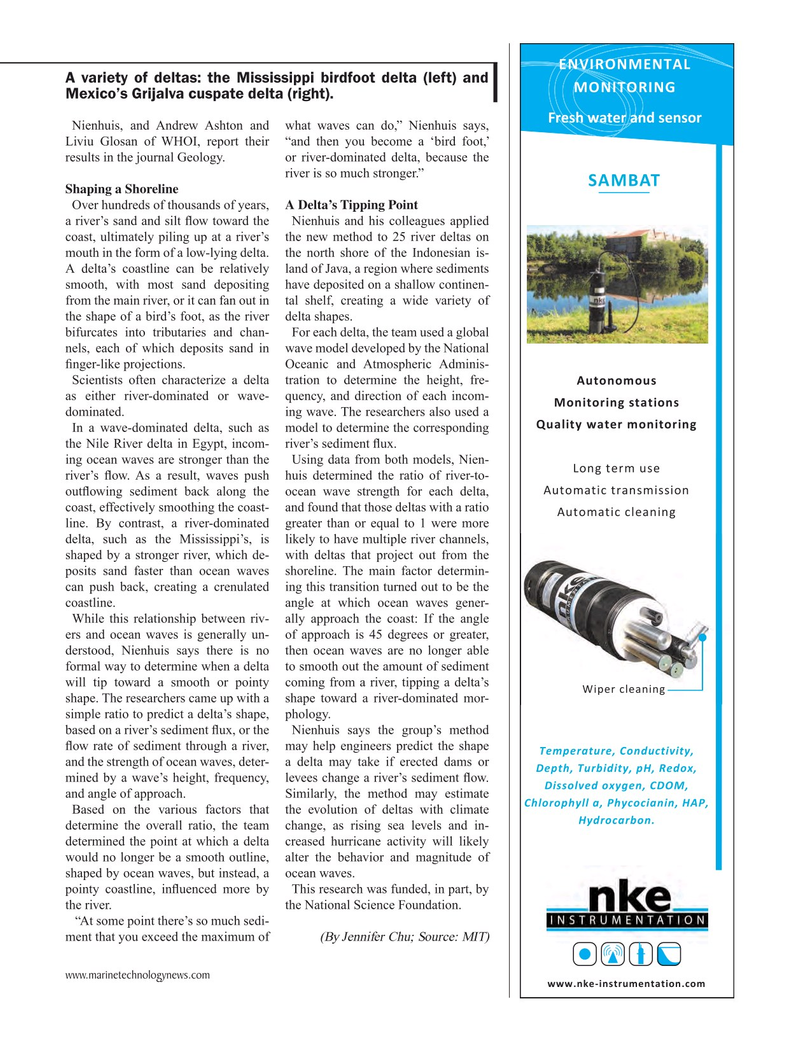
Page 45: of Marine Technology Magazine (November 2015)
Read this page in Pdf, Flash or Html5 edition of November 2015 Marine Technology Magazine
ENVIRONMENTAL
A variety of deltas: the Mississippi birdfoot delta (left) and
MONITORING
Mexico’s Grijalva cuspate delta (right).
Fresh water and sensor
Nienhuis, and Andrew Ashton and what waves can do,” Nienhuis says,
Liviu Glosan of WHOI, report their “and then you become a ‘bird foot,’ results in the journal Geology. or river-dominated delta, because the river is so much stronger.”
SAMBAT
Shaping a Shoreline
Over hundreds of thousands of years, A Delta’s Tipping Point a river’s sand and silt ? ow toward the Nienhuis and his colleagues applied coast, ultimately piling up at a river’s the new method to 25 river deltas on mouth in the form of a low-lying delta. the north shore of the Indonesian is-
A delta’s coastline can be relatively land of Java, a region where sediments smooth, with most sand depositing have deposited on a shallow continen- from the main river, or it can fan out in tal shelf, creating a wide variety of the shape of a bird’s foot, as the river delta shapes.
bifurcates into tributaries and chan- For each delta, the team used a global nels, each of which deposits sand in wave model developed by the National ? nger-like projections. Oceanic and Atmospheric Adminis-
Scientists often characterize a delta tration to determine the height, fre-
Autonomous as either river-dominated or wave- quency, and direction of each incom-
Monitoring stations dominated. ing wave. The researchers also used a
Quality water monitoring
In a wave-dominated delta, such as model to determine the corresponding the Nile River delta in Egypt, incom- river’s sediment ? ux.
ing ocean waves are stronger than the Using data from both models, Nien-
Long term use river’s ? ow. As a result, waves push huis determined the ratio of river-to-
Automatic transmission out? owing sediment back along the ocean wave strength for each delta, coast, effectively smoothing the coast- and found that those deltas with a ratio
Automatic cleaning line. By contrast, a river-dominated greater than or equal to 1 were more delta, such as the Mississippi’s, is likely to have multiple river channels, shaped by a stronger river, which de- with deltas that project out from the posits sand faster than ocean waves shoreline. The main factor determin- can push back, creating a crenulated ing this transition turned out to be the coastline. angle at which ocean waves gener-
While this relationship between riv- ally approach the coast: If the angle ers and ocean waves is generally un- of approach is 45 degrees or greater, derstood, Nienhuis says there is no then ocean waves are no longer able formal way to determine when a delta to smooth out the amount of sediment will tip toward a smooth or pointy coming from a river, tipping a delta’s
Wiper cleaning shape. The researchers came up with a shape toward a river-dominated mor- simple ratio to predict a delta’s shape, phology.
based on a river’s sediment ? ux, or the Nienhuis says the group’s method ? ow rate of sediment through a river, may help engineers predict the shape
Temperature, Conductivity, and the strength of ocean waves, deter- a delta may take if erected dams or
Depth, Turbidity, pH, Redox, mined by a wave’s height, frequency, levees change a river’s sediment ? ow.
Dissolved oxygen, CDOM, and angle of approach. Similarly, the method may estimate
Chlorophyll a, Phycocianin, HAP,
Based on the various factors that the evolution of deltas with climate
Hydrocarbon. determine the overall ratio, the team change, as rising sea levels and in- determined the point at which a delta creased hurricane activity will likely would no longer be a smooth outline, alter the behavior and magnitude of shaped by ocean waves, but instead, a ocean waves.
pointy coastline, in? uenced more by This research was funded, in part, by the river. the National Science Foundation.
“At some point there’s so much sedi- ment that you exceed the maximum of (By Jennifer Chu; Source: MIT) www.marinetechnologynews.com www.nke-instrumentation.com
MTR #9 (34-49).indd 45 12/9/2015 10:42:01 AM

 44
44

 46
46
